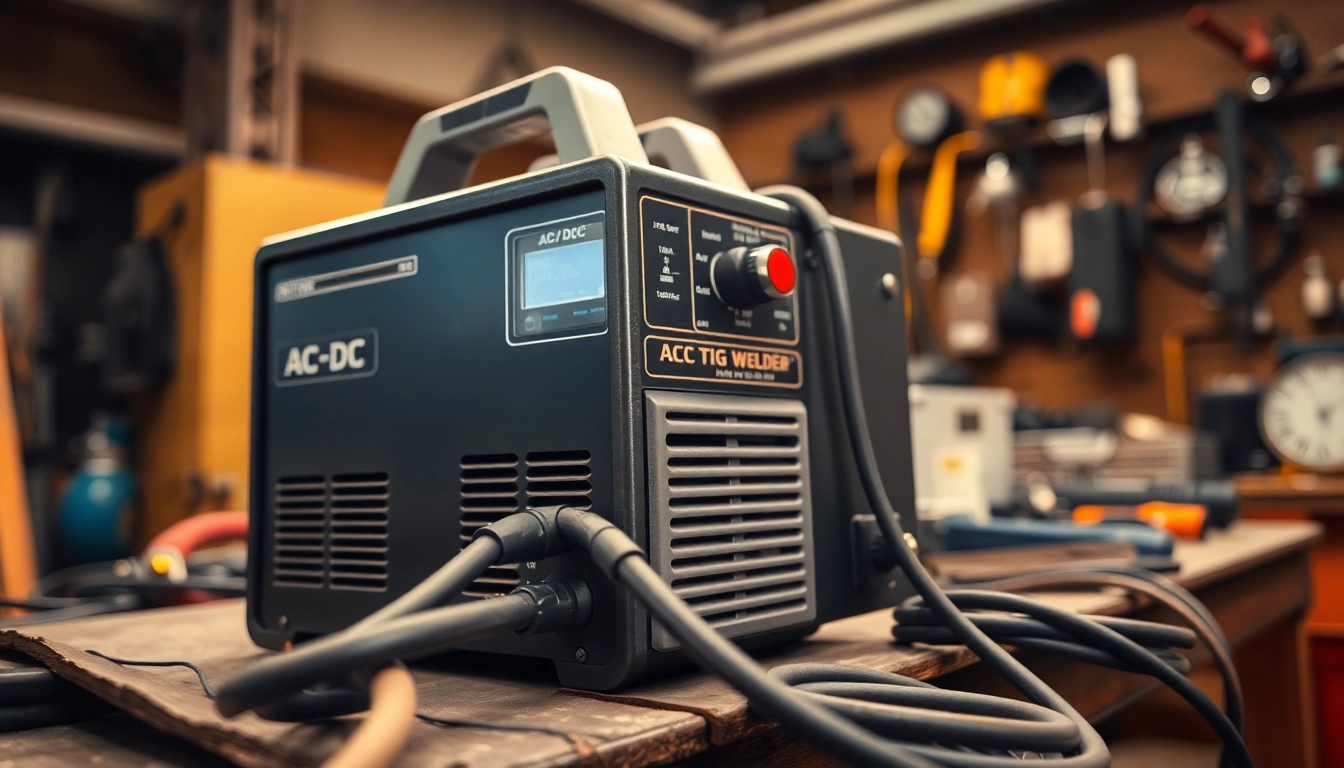Understanding AC DC TIG Welding Technology
What is AC DC TIG Welding?
Tungsten Inert Gas (TIG) welding is a precision welding process that employs a non-consumable tungsten electrode to produce the weld. The versatility of TIG welding primarily lies in its ability to operate on both alternating current (AC) and direct current (DC). This feature allows welders to use the method on a wide range of metals including aluminum, stainless steel, copper, and titanium. An ac dc tig welder can switch between the two currents, making it a particularly valuable tool for professionals working in diverse industrial settings.
Benefits of AC DC Over Standard TIG Welders
The primary advantage of owning an AC/DC TIG welder lies in its flexibility to handle a variety of welding applications effectively. Here are some crucial benefits:
- Metal Versatility: AC welding is ideal for aluminum and other non-ferrous metals due to its cleaning action, helping to remove any oxide that can impede the welding process. DC welding is suitable for ferrous metals like stainless steel and carbon steel.
- Better Control: The ability to adjust current settings allows for precise control over heat input. This is particularly important when welding thin materials or intricate designs where overheating can result in warping or burn-through.
- Longer Electrode Life: Because DC TIG welding is less aggressive on the tungsten electrode, it extends the lifespan of the electrode, which can lead to fewer interruptions and more efficient welding operations.
- Quality Welds: The cleanliness and stability of the arc in AC/DC TIG welding produce high-quality welds with minimal contamination and defects.
Key Features to Look for in an AC DC TIG Welder
When considering the purchase of an AC/DC TIG welder, there are several features that can significantly impact performance and usability:
- Pulse Functionality: This feature allows the welder to control heat input more effectively by pulsing the current, which is beneficial for thin materials.
- AC Balance Control: Adjusting the AC balance can help clean the oxide layer during aluminum welding while minimizing electrode wear.
- Auto-Set Features: Some welders come equipped with auto-set parameters to simplify the process for beginners, reducing the learning curve.
- Foot Pedal Control: A remote foot pedal enables the welder to adjust the amperage while keeping their hands free to manipulate the torch, enhancing comfort and control.
- Duty Cycle: The duty cycle indicates how long the welder can operate before needing a break to cool down. A higher duty cycle is preferable for prolonged work sessions.
Choosing the Right AC DC TIG Welder for Your Needs
Factors Influencing Your Selection
Selecting the appropriate AC/DC TIG welder requires a thorough understanding of your specific welding needs. Here are several key factors to consider:
- Welding Material: Identify the types of metals you will most frequently weld, as this will determine whether you favor a model with robust AC capabilities or a DC-only option.
- Welding Thickness: If you often work with thin materials, choose a welder with precise control settings and a good pulse feature.
- Portability: If you need to transport your welder frequently, consider the size and weight. A model with a compact design and integrated handles may be more suitable.
- Budget: Pricing can vary significantly among models. Determine your budget before you start exploring options to narrow down your choices.
- Future Needs: Consider whether you might want to tackle more complex projects in the future that might require additional features.
Top Brands and Models Reviewed
Several brands specialize in manufacturing top-quality AC/DC TIG welders. Some notable manufacturers and their standout models include:
- Miller Electric: Known for its reliability, the Miller Dynasty 210 offers advanced features like Auto-Set and is highly versatile for both AC and DC welding.
- Lincoln Electric: The Lincoln Square Wave TIG 200 is widely recognized for its intuitive design and effective performance on a variety of materials, especially aluminum.
- Everlast: The PowerTIG 250EX is celebrated for providing professional-grade features at a more accessible price point, making it a favorite among hobbyists and professionals alike.
- Hobart: The Hobart EZ-TIG 165 stands out for its simplicity and ease of use, ideal for less experienced welders aiming to get started with TIG welding.
Customer Feedback and Insights
Customer reviews can provide invaluable insights into the real-world performance of AC/DC TIG welders. Notable trends based on user feedback often highlight:
- Ease of setup and initial use.
- Quality of customer support offered by manufacturers.
- Satisfaction with the welder’s capabilities in performing intricate welds.
- Common appreciation for models featuring digital displays and intuitive controls.
Prospective buyers are encouraged to explore user reviews and expert comparisons before making a decision, as these can significantly aid in selecting the right model for their specific needs.
Tips for Operating Your AC DC TIG Welder Effectively
Setting Up for Your First Use
Preparing your AC/DC TIG welder for its first use is a crucial step to ensure optimal performance. Here’s a guide to getting started:
- Read the Manual: Each model has unique features and setup instructions. Familiarize yourself with your specific machine.
- Assemble the Welder: Connect the torch, ground clamp, and any additional components following the manufacturer’s guidelines.
- Check Argon Gas Supply: Ensure that the argon cylinder is properly connected and check for leaks.
- Set the Right Parameters: Adjust the amperage, voltage, and AC balance depending on the material thickness and type.
- Test Weld: Run a test weld on scrap material similar to your intended project; this will help you fine-tune the settings before moving on to your actual work.
Common Welding Techniques Explained
Familiarity with various welding techniques will enhance your skillset and lead to better results. Here are several essential techniques employed in AC/DC TIG welding:
- Stringer Bead: This technique involves moving the torch in a straight line without weaving; it is commonly used for welding thin materials.
- Weave Pattern: Weaving back and forth increases the heat input over a broader area, suitable for thicker materials.
- Pecking Technique: This involves short bursts of welding to control heat while allowing for better penetration in thick settings.
- Push vs Pull: Many welders prefer pushing the torch forward for aluminum welding and pulling for stainless steel to enhance penetration and control.
Maintenance Tips for Longevity
To maintain the performance and extend the life of your AC/DC TIG welder, adhere to these maintenance practices:
- Regular Cleaning: Keep the welder clean, especially the torch and the nozzles, to avoid spatter buildup that could affect performance.
- Inspect Cables: Regularly check for any wear or damage on cables and connections to ensure safe operation.
- Replace Electrodes: Monitor the condition of your tungsten electrodes and replace them according to usage patterns to maintain weld quality.
- Check Gas Supply: Ensure that you always have sufficient argon gas and replace cylinders as needed.
Common Challenges When Using AC DC TIG Welders
Identifying and Solving Inconsistencies
Welders often encounter various inconsistencies in the welding process. Recognizing common issues early can help resolve them efficiently:
- Porosity: This occurs due to contamination or insufficient gas coverage. Ensure proper gas flow and clean surfaces before welding.
- Burn-through: Too much heat can lead to holes in thin materials. Adjusting amperage and travel speed can rectify this issue.
- Inconsistent Bead Appearance: This can be a result of improper settings, welding speed, or technique. Experimenting with different settings can help achieve a consistent finish.
Adapting to Different Materials
Each metal type presents specific challenges and techniques for effective welding. Understanding the differences can significantly enhance your results:
- Aluminum: Use AC current with a cleaning action to remove oxides. Control heat input through the use of pulsing.
- Stainless Steel: DC current is often employed. Mild heat is crucial to avoid warping and maintaining a shiny finish without excessive discoloration.
- Carbon Steel: This metal generally uses DC and with appropriate travel speed to achieve optimal penetration without distortion.
Safety Best Practices for New Users
Safety is paramount when operating a TIG welder. New users should adhere to these safety guidelines:
- Wear Protective Gear: This includes welding gloves, helmets with proper shade, and flame-resistant clothing to shield against sparks and UV radiation.
- Ensure Proper Ventilation: Welding fumes can be harmful. Always work in well-ventilated areas or use appropriate fume extractors.
- Be Aware of Electrical Hazards: Ensure that your equipment is in good working order, and avoid wet environments when welding to reduce shock risks.
Latest Innovations in AC DC TIG Welding
Emerging Technologies and Trends
The welding industry has seen remarkable advancements in technology, particularly in AC/DC TIG welding systems. Some of the most disruptive innovations include:
- Inverter Technology: Modern welders utilize inverter technology, allowing for smaller and lighter machines without compromising on power or efficiency.
- Wireless Controls: Many new models now feature digital interfaces and wireless remote controls for easily adjusting settings without being tethered by cables.
- Smart Welders: Manufacturers are integrating smart technology, enabling diagnostics and customizable settings through mobile applications.
Comparative Analysis of Newer Models vs. Older Ones
When evaluating the differences between older and newer models, users can expect:
- Efficiency Improvements: New models often consume less energy while providing more power and better arc stability.
- Enhanced User Interface: Most contemporary machines are equipped with user-friendly controls, making them more accessible for beginners compared to older counterparts.
- Better Cooling Systems: Innovations in cooling technologies lead to higher performance and longevity for modern welders under demanding conditions.
Future of Welding with AC DC Technologies
The future of AC/DC TIG welding looks promising, with continual advancements expected in automation, artificial intelligence, and even further integration of IoT devices. As manufacturers innovate, users can look forward to:
- More sophisticated weld monitoring systems that provide real-time feedback.
- Efficient predictive maintenance alerts to prevent downtime.
- Increased connectivity to additional tools and materials for seamless operation.



